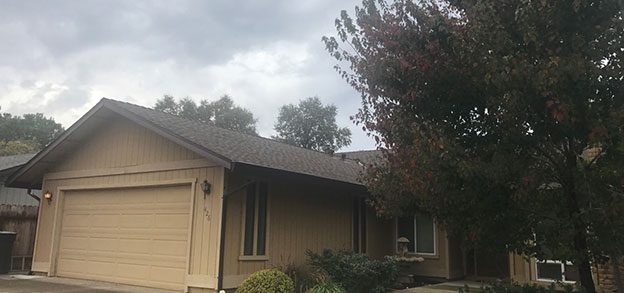Learn More About Roofing Installation
Understand How The Elements Affect Your Roof
Is your roofing really in trouble?
There are several key signs that indicate trouble with your roof. These include:
- Leaks in your attic/top floor when it’s rainy or icy outside
- Ceiling stains; blistering or peeling ceiling paint
- Flaking, decayed or dirty areas around your roof
- Cracking or curling shingles
- Low energy efficiency in your home

Know Your Roofing Enemies
In its Guide for Homeowners, the National Roofing Contractor’s Association details common enemies of roofs. Depending on your geographical location and climate, you will undoubtedly have some of these roofing enemies. This information is useful as you evaluate your roofing options and make the decision to upgrade or replace your roof.
Sun
Heat and ultraviolet rays cause roofing materials to deteriorate over time. Deterioration can occur faster on the sides facing west or south.
Rain
When water gets underneath shingles, shakes or other roofing materials, it can work its way to the roof deck and cause the roof structure to rot. Extra moisture encourages mildew and rot elsewhere in a house, including walls, ceilings, insulation and electrical systems.
Wind
High winds can lift shingles’ edges (or other roofing materials) and force water and debris underneath them. Extremely high winds can cause extensive damage.
Snow And Ice
Melting snow often refreezes at a roof’s overhang where the surface is cooler, forming an ice dam. This blocks proper drainage into the gutter. Water backs up under the shingles (or other roofing materials) and seeps into the interior. During the early melt stages, gutters and downspouts can be the first to fill with ice and be damaged beyond repair or even torn off a house or building.
Condensation
Condensation can result from the buildup of relatively warm, moisture-laden air. Moisture in a poorly ventilated attic promotes decay of wood sheathing and rafters, possibly destroying a roof structure. Sufficient attic ventilation can be achieved by installing larger or additional vents and will help alleviate problems because the attic air temperature will be closer to the outside air temperature.
Moss And Algae
Moss can grow on moist wood shingles and shakes. Once it grows, moss holds even more moisture to a roof system’s surface, causing rot. In addition, moss roots can also work their way into a wood deck and structure. Algae also grows in damp, shaded areas on wood or asphalt shingle roof systems. Besides creating a black-green stain, algae can retain moisture, causing rot and deterioration. Trees and bushes should be trimmed away from homes and buildings to eliminate damp, shaded areas, and gutters should be kept clean to ensure good drainage.
Trees And Leaves
Tree branches touching a roof will scratch and gouge roofing materials when the branches are blown by the wind. Falling branches from overhanging trees can damage, or even puncture, shingles and other roofing materials. Leaves on a roof system’s surface retain moisture and cause rot, and leaves in the gutters block drainage.
Missing Or Torn Shingles
The key to a roof system’s effectiveness is complete protection. When shingles are missing or torn off, a roof structure and home or building interior are vulnerable to water damage and rot. The problem is likely to spread—nearby shingles also are ripped easily or blown away. Missing or torn shingles should be replaced as soon as possible.
Shingle Deterioration
When shingles are old and worn out, they curl, split and lose their waterproofing effectiveness. Weakened shingles easily are blown off, torn or lifted by wind gusts. The end result is structural rot and interior damage. A deteriorated roof system only gets worse with time—it should be replaced as soon as possible.
Flashing Deterioration
Many apparent roof leaks really are flashing leaks. Without good, tight flashings around chimneys, vents, skylights and wall/roof junctions, water can enter a home or building and cause damage to walls, ceilings, insulation and electrical systems. Flashings should be checked as part of a biannual roof inspection and gutter cleaning.
— From the National Roofing Contractors Association
Request a Free In-Home Consultation Or Call: (916) 533-3939









